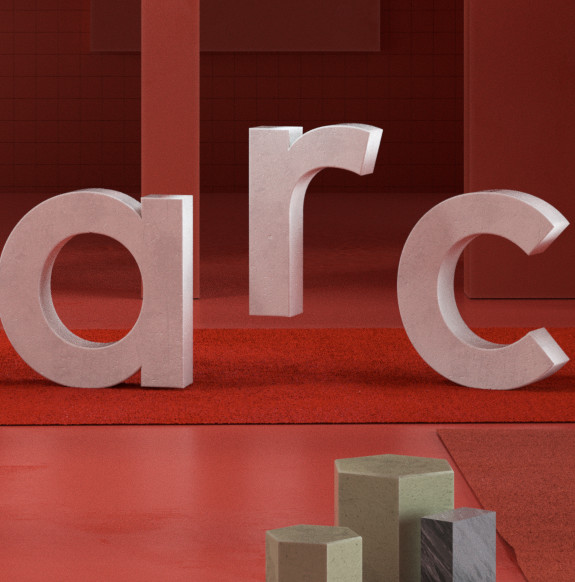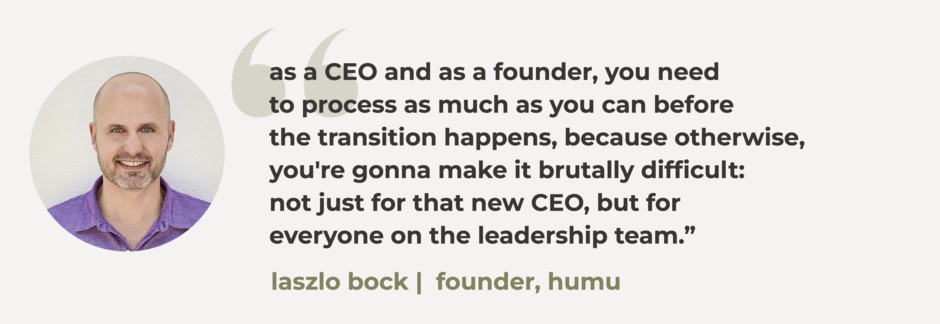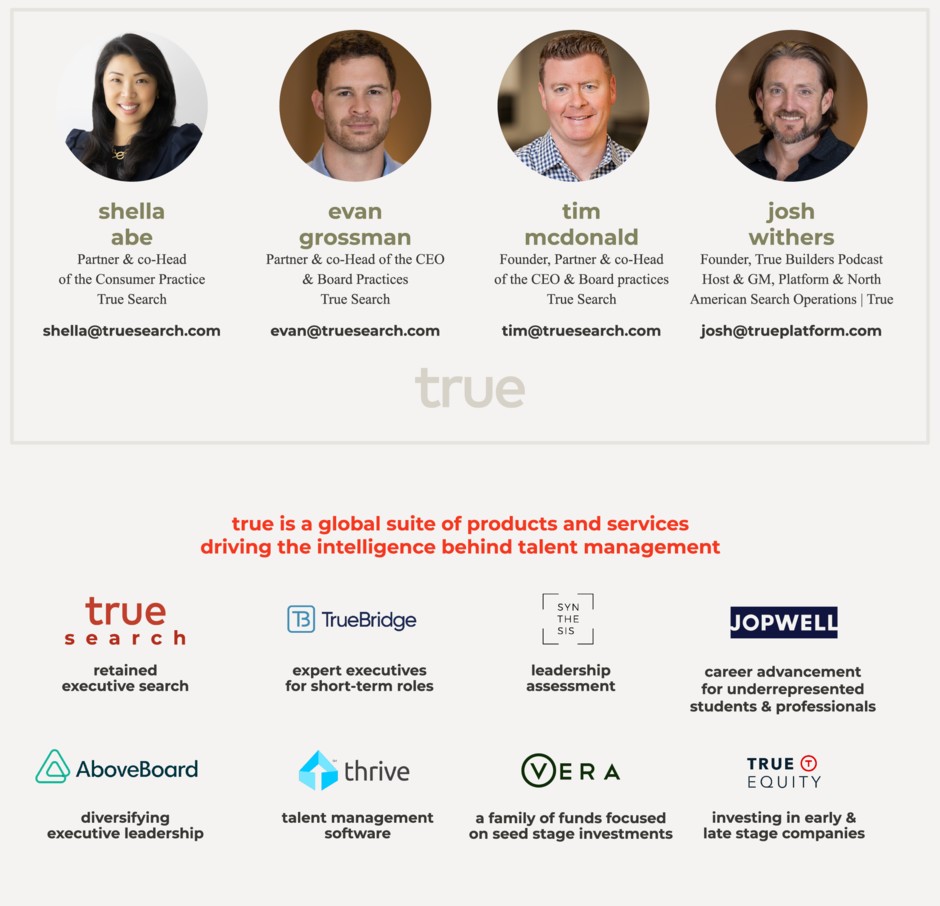



















There are endless reasons a founder/CEO may step down from leading the company they’ve started. But there are far fewer ways to get the transition to the first new CEO right.
True has worked with countless founders at these inflection points (over 400 CEO searches in the past three years) and has seen every kind of transition: the good, the bad, and the incredibly successful.
With expertise from True partners, clients, founders and investors, the CEO practice is sharing case studies from best-in-class founder transitions and will explain:
Reasons founders step aside.
Who should be on the CEO search committee.
How involved the founder should be.
The role of the executive search team.
How to set the new CEO up for success.
We hope this article provides helpful guideposts for founders, boards and investors to follow, and makes this critical transition a little easier.

Some founders are builders and visionaries that aren’t as interested or prepared for a larger company’s needs. In other situations, there may be an approaching change like an IPO, where the company needs a leader with more experience in the public-company environment. Sometimes, it’s personal.

While there is never a perfect time for a founder to transition out of the CEO role, there are some telltale signs that shouldn't be ignored.


Eight years and over 200 franchise locations after starting Restore, Jim knew he was overdue for the next challenge. He told his team, his franchise owners, and announced on social media.
Since then, he’s intentionally kept a distance from the search process to let the search firm and his company’s PE investor, General Atlantic, do their work. “You have to trust the process and trust the team,” Jim said. “The reason I'm stepping down is because the company needs a new type of CEO. They know what they're looking for to get a company to a public offering. And so, why wouldn't I let them drive this process?”
Jim says that while his employees have known him as a person who feels deeply connected to his people, he has no plans to stay too close to the day-to-day of Restore going forward.
“If you left a good team in place and you left enough of your DNA, the team should not have you looking over their shoulder second-guessing. For the most part, I went the opposite way and said, ‘all the ingredients are here.’’’

Of course, not all founders are so self aware, and not all companies are so successful. Sometimes they’re told ‘it’s time to go’ by others.
Scale Venture Partners’ Rory O’Driscoll has been investing in enterprise software for 25 years into companies like Box, Docusign and Bill.com. He said it's the investor’s job to do what’s right for the company and tell tough truths.
“An investor friend of mine used to say, ‘Listen to the brain in your gut.’ I do know very clearly when I've lost confidence and when I think a founder is not going to get there.” Rory said.

That conversation can happen when the company is doing poorly, but also when the company is successful but needs new leadership for the next stage. The latter is a tougher situation, Rory said, but the payoff, for everyone including the founder, is bigger.
“When things are going well enough, it's harder to deal with the founder because there's a lot of bias for them to say, ‘I got this,’’’ Rory said. “But those are the decisions where if you do it, you can take a really good business and make it great.

Co-founder and former CEO of Corelight Greg Bell wants to reassure other founders thinking about transitioning: “Jump in, the water’s fine.”
Five years into the CEO role, Greg was closing round C and realized his cybersecurity company needed a CEO with a different skill set to get to the next level.
“I felt like, ‘Well, this is likely to be a very successful, possibly independent company worth quite a lot of money.’” Greg said. “And a lot of the art of scaling it seemed to be on the go-to-market side.”
He realized he had a few choices, and one of them was to let the board know he wanted to hire a new CEO with that critical experience. “And I would move into a job where I thought I would, frankly, have more fun and be better suited,” Greg said.
And that’s what he did. Greg worked with True to hire Brian Dye as CEO and transition to a Chief Strategy Officer role. Today he focuses on corporate development, alliances, and the open source side of what Corelight does. It’s a startup role in a company that’s no longer quite a startup. He said, “I think on average, I’m happier.”

True co-founder and True Builders podcast host Josh Withers ran the search team for Greg’s successor. He remembers Greg as the ultimate example of CEO cooperation.
“Many founders are miserable about being replaced even if they agree it's time,” Josh said.
(Listen to Greg and Josh talk founder transitions on the True Builders podcast)


True co-founder Tim McDonald co-leads the CEO practice with Evan Grossman. He said, ideally the board forms a subcommittee to work with True. Typically, it’s led by the chairman of the board, or appointed board members who form the selection committee and work alongside True to interview and assess candidates.

It’s healthy for founders to be part of the search process, but this varies. In a best-in-class situation, founders are there throughout the search to educate and excite the next CEO about the business.

If the founder is not involved, it may be the CFO playing their part. It all depends on who the company trusts most, and who best understands business needs.
And what if the situation is tenuous and the founder is not a willing participant in the process? Then it’s best they're not involved at all. A disgruntled founder will disrupt the search process, and lessen the chance of landing a great candidate.

Of course, there are exceptions to these rules. Shella Abe, who has led major CEO searches for the world’s top beauty, fashion and lifestyle brands, says for most of her clients, the founder often has a highly visible and personal connection to the brand. They may be the “face” of the brand, closely associated with its ethos and values.
“These founders are frequently involved in creative aspects such as product development and brand marketing,” Shella said. “Their unique insights and creativity are closely tied to the brand’s success, making it crucial to find a CEO who can complement this creative direction. The founder will need to work closely with the incoming CEO and ensure a close collaboration for a smooth transition and the ongoing success of the brand.”

Before Kickoff
The core job of the executive search team is to run an efficient process. From the start, the team will give clients their opinion on how the process should run. (Format can vary depending on who has company ownership and who the key decision makers are.) The search team will then build a talented slate of qualified candidates that have been assessed through interviews, research and referencing.
Align on Your Message
It’s critical that everyone aligns on messaging and the spec for the next CEO. Executive search teams spend time up front with all key stakeholders, including the founder, listening and learning, to make sure there's alignment in terms of ‘why now’ and ‘what type’ of leader is needed. Candidates will be looking for consistent answers to these questions during the interview process.
After Kickoff
After the search begins, the recruiters will relay market feedback on how the business is being perceived. They will communicate with their client if there is any type of negativity in the market, or if something about the role description or compensation isn't working.

“We can assess what’s going well, identify what hasn't gone well, and course correct to get the result everybody wants.” Tim said.

As author of the best-selling management book Work Rules and former SVP of People Operations at Google, Laszlo Bock was already well-educated on founder transitions when it came time for his own from HR tech company Humu (acquired by Perceptyx).
He was also personally aware: His father had demonstrated how to step away when he sold Bock Engineering, the company he’d founded 30 years before as a Romanian refugee. Two years after the sale, Bock Engineering was out of business: run into the ground by the person who’d bought it.
“I remember asking him, ‘Dad, your name was on the door. You built this thing. It must feel terrible.’" Laszlo recounted. “And he said, ‘It doesn't feel terrible at all. It was mine. And then I sold it. And now it's not mine.’”
For Laszlo, it was a powerful lesson about how you do these transitions. When it was time to leave his founder/CEO role at Humu, he made sure he was personally ready to hand over the reins before he informed his co-founder Wayne Crosby and the board of his decision. He advised other founders to mentally prepare themselves before starting.

Before beginning the search, Laszlo worked closely with True CEO Practice co-lead Evan to understand and refine what skills and expertise Humu needed from its next leader. With the help of the board, they landed on a profile of a CEO with product and operational expertise. They took that profile to market and eventually found Scott Chancellor for the role.
“It was really helpful that the board, my co-founder, and I were all 100% aligned on needing somebody who deeply deeply understands how to build products that customers love. That was the most essential, critical piece, and that alignment really helped us with screening,” Laszlo said.

The last piece of the puzzle is deciding what the founder’s role will be going forward. Are they going to stay with the company? Remain on the board? Move over to a chief strategy officer or another technical role? Founders have unique insight on the product, market, and inner workings of the business, and are the best resource to the incoming CEO for a smooth transition.
Laszlo recalled how he met with the new Humu CEO three times a week initially, which tapered off to every two weeks, and then to consultations as needed.
Likewise, after Greg handed control of Corelight to his former chief product officer Brian, he was rigorous about establishing to everyone that Brian was the new boss.
“We established clear swim lanes,” Greg said. “There was absolutely no hint of any ambiguity around the fact that Brian was CEO and he had all the duties and responsibilities of CEO.”
